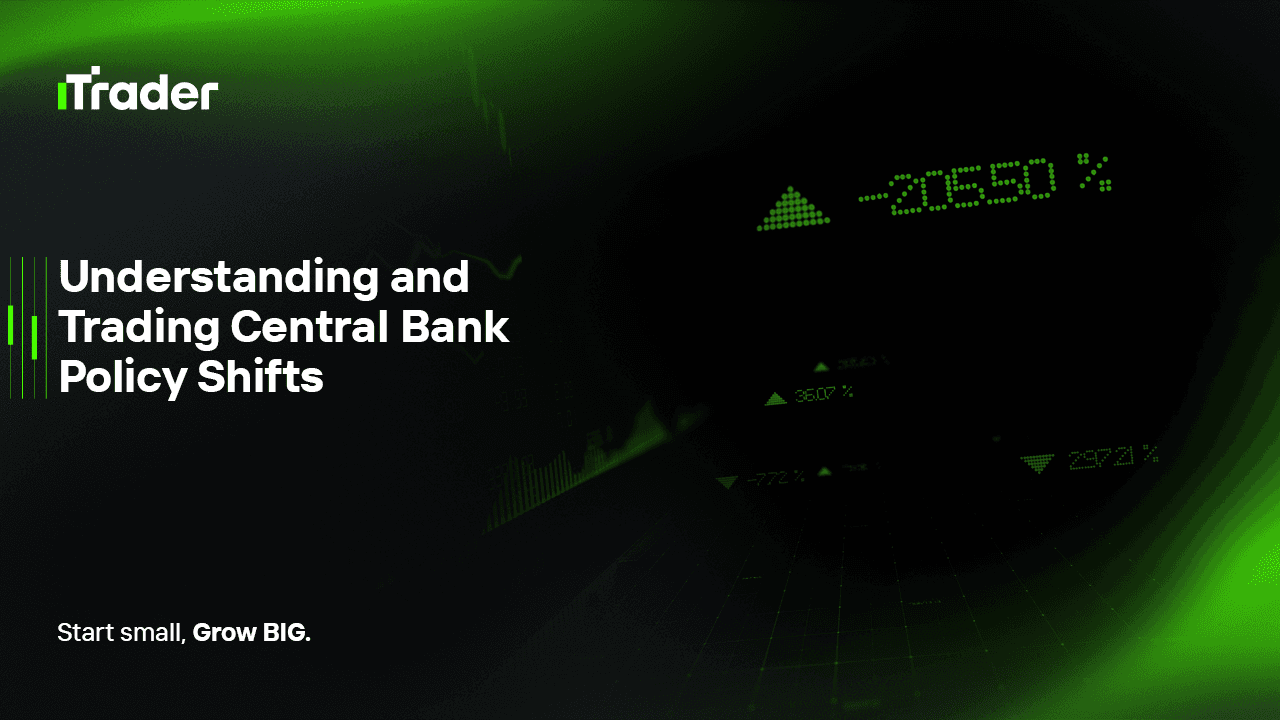2025-08-28
The forex market is one of the most sensitive arenas in global finance. Exchange rates not only respond to day-to-day technical fluctuations but also to major macroeconomic policy decisions. Among these, the most powerful drivers are monetary policy shifts by central banks.
Institutions like the U.S. Federal Reserve (Fed), European Central Bank (ECB), Bank of Japan (BOJ), and Bank of England (BoE) regularly influence global capital flows through interest rate decisions, quantitative easing (QE), balance sheet adjustments, and policy guidance. These decisions ripple across the forex market, creating both risks and opportunities.

For prop traders, understanding and anticipating central bank policy shifts is not just about catching a trade—it’s a strategic edge. Prop firm challenges measure not only short-term profitability but also how effectively traders manage risk in volatile, news-driven conditions.
Central banks operate with three main goals:
They achieve these through various policy tools:
Interest rates are the most direct channel through which central banks influence currency values.
This concept underpins the classic Interest Rate Differential strategy, where traders position based on relative yields between economies.
Markets react not only to the decision itself but also to how it aligns with prior expectations:
Central bank policy affects currencies via multiple channels:
In certain cases, central banks intervene directly, buying or selling their currency to stabilize exchange rates. The BOJ, for instance, has stepped in to curb excessive yen weakness.
When central banks follow opposite policy paths, strong forex opportunities emerge. Example: Fed tightening vs. ECB easing led to EUR/USD weakness in 2014–2015.
For prop traders, the risk around central bank events is heightened volatility. Effective practices include:
The Swiss National Bank removed its EUR/CHF floor, causing the franc to surge ~30% within minutes. Many retail and institutional traders were wiped out.
Successive Fed hikes boosted USD strength across major pairs, rewarding traders who anticipated the policy cycle.
Policy tweaks and interventions triggered strong yen volatility, creating both risks and short-term opportunities.
Since firms evaluate risk discipline, traders must:
Prop traders need to interpret not just the numbers but also the tone of central bank communication. A single phrase in a press conference can move markets. Skills include:
Central bank monetary policy is one of the dominant forces shaping forex markets. For prop traders, mastering this area provides both protection against unnecessary risk and an edge in capturing high-probability setups.
Ultimately, central bank policy sets the rules of the forex game. Traders who can read, anticipate, and adapt to these rules are far more likely to pass prop firm challenges and thrive in live market conditions.
© 2025 iTrader Global Limited | หมายเลขทะเบียนบริษัท: 15962
iTrader Global Limited ตั้งอยู่ที่ Hamchako, Mutsamudu, เกาะปกครองตนเอง Anjouan, สหภาพคอโมโรส และได้รับใบอนุญาตและอยู่ภายใต้การกำกับดูแลของคณะกรรมการหลักทรัพย์แห่งคอโมโรส ภายใต้หมายเลขใบอนุญาต L15962/ITGL
iTrader Global Limited ดำเนินการภายใต้ชื่อทางการค้า “iTrader” และได้รับอนุญาตให้ดำเนินกิจกรรมการซื้อขายฟอเร็กซ์ โลโก้ เครื่องหมายการค้า และเว็บไซต์ของบริษัทเป็นทรัพย์สินเฉพาะของ iTrader Global Limited
บริษัทย่อยอื่น ๆ ของ iTrader Global Limited ได้แก่ iTrader Global Pty Ltd หมายเลขทะเบียนบริษัทออสเตรเลีย (ACN): 686 857 198 โดยบริษัทนี้เป็นตัวแทนที่ได้รับอนุญาต (หมายเลขตัวแทนบริการทางการเงินของออสเตรเลีย (AFS): 001315037) ของ Opheleo Holdings Pty Ltd (ใบอนุญาตบริการทางการเงินของออสเตรเลีย (AFSL): 000224485) ซึ่งมีที่อยู่จดทะเบียนอยู่ที่ Level 1, 256 Rundle St, Adelaide, SA 5000 ข้อจำกัดความรับผิดชอบ: นิติบุคคลนี้ไม่ใช่ผู้ออก และไม่รับผิดชอบต่อผลิตภัณฑ์ทางการเงินที่ซื้อขายบนหรือผ่านเว็บไซต์นี้
คำเตือนความเสี่ยง: การซื้อขาย CFD มีความเสี่ยงสูงต่อการสูญเสียเงินทุนอย่างรวดเร็วเนื่องจากเลเวอเรจ และอาจไม่เหมาะสมกับผู้ใช้ทุกคน
การซื้อขายกองทุน CFD และผลิตภัณฑ์ที่มีเลเวอเรจสูงอื่น ๆ ต้องการความรู้เฉพาะทาง
จากผลการวิจัยพบว่า 84.01% ของผู้เทรดที่ใช้เลเวอเรจประสบกับการขาดทุน
โปรดตรวจสอบให้แน่ใจว่าคุณเข้าใจความเสี่ยงทั้งหมด และพร้อมที่จะสูญเสียเงินทุนก่อนที่คุณจะเข้าร่วมการซื้อขายที่มีเลเวอเรจ
iTrader ขอประกาศว่า บริษัทจะไม่รับผิดชอบต่อความเสี่ยง ความเสียหาย หรือการสูญเสียใด ๆ ที่เกิดขึ้นจากการซื้อขายแบบมีเลเวอเรจต่อบุคคลหรือนิติบุคคลใด ๆ ทั้งสิ้น
ข่าวสารและข้อมูลที่ปรากฏบนเว็บไซต์นี้มีไว้เพื่อวัตถุประสงค์ทางการศึกษาเท่านั้น ผู้ใช้ควรตัดสินใจทางการเงินอย่างอิสระและโดยใช้ข้อมูลอย่างรอบคอบ
ข้อจำกัด: iTrader ไม่ได้มุ่งเป้าเว็บไซต์หรือบริการไปยังผู้อยู่อาศัยในประเทศที่กฎหมายหรือข้อบังคับห้ามไม่ให้มีการทำธุรกรรมดังกล่าว
หากคุณอาศัยอยู่ในเขตอำนาจที่การใช้เว็บไซต์หรือบริการนี้ถูกจำกัด คุณต้องรับผิดชอบในการปฏิบัติตามกฎหมายท้องถิ่น
iTrader ไม่รับประกันว่าเนื้อหาบนเว็บไซต์ของบริษัทจะเหมาะสมหรือถูกต้องตามกฎหมายในทุกพื้นที่